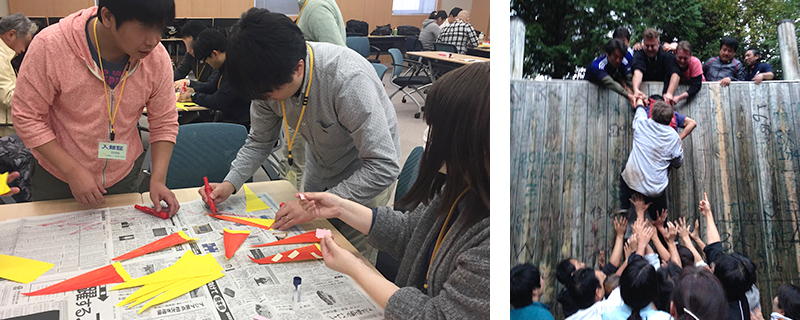The organization places customers at the center, and works collaboratively in the work required to do so.
In organizations that have realized empowerment, the members are linked through trust, where they are encouraged to have a fluid exchange of opinions, and to not fear failure. In order to maximize the value provided to customers, they continuously work on improving performance, so they can reach ever higher levels of productivity, as a team.
Supporting the creation of relationships promoting collaboration
In order to become a high performance team, there is a need to have each individual have a sense of being able to comfortably communicate, feeling they are accepted by the team, where there is mutual trust and respect. In order to do so, we will nourish members so they have a greater understanding of each other, and have a safe organization, where they can hold open discussions.
Collaborative learning: Learn from each other’s experiences
Through holding a dialogue with the Team concerning the theme, there is support for mutual learning and growth. Based on the gross mindset, and not only successful cases, the learnings of the Team will be more significant through disclosing failure cases and their learnings.
Example of this program
High performance team building
Outline
This is a program where the team members become one in facing the issues in communication, while keeping in mind the team they envision, sharing the organization and team vision and strategy, in order to realize a high performance culture, where the organization or team provide major results.
Duration
1day program
Audience
This is executed by organization or team units. Appropriate number of participants : TBD
Expected deliverables
- Close the emotional gaps, and further deepen mutual understanding
- Share the team envisioned, and raise the commitment to realize that
- Reflect on own actions, and clarify the contents of the actions required to become a high performance team
Program
| Theme | Contents |
|---|---|
| What is a high performance team? |
|
| Envision the organization desired (what kind of organization/team you want to become) |
|
| Our challenges in realizing this |
|
* The activity can be provided through various programs, depending upon the circumstances and needs of the team.

Circles
Outline
While receiving support, through regular and consistent dialogue with other members, this is a place for constant learning, working on challenges that push you to personal growth.
For issues you are facing, look to the issues that exist within you, and while obtaining support from members concerning how you should work on that issue, create an action plan. Implement the action plan back in the field and bring back the learnings from such to the next session and seek further growth.
Duration
1 session is roughly 2-hours, held once a month for 6-months
Audience
It is possible to execute based on the objective, from new hires to executives
Expected deliverables
- Reflect upon your own actions, clarifying the necessary behavioral changes
- Be able to obtain hints related to self growth, building relationships, organizations and business, from other member experiences
- Your relationships with other members will be enhanced, and you will gain a deeper understanding of other business units
Standard process for Circles
1. Opening
- Confirm the ground rules
- Confirm the dialogue themes
2. Dialogue (time to be evenly divided among members)
- Each to proceed in order, in line with the frame
- In each of the Circles sessions, each member will have the same amount of time to reflect on themselves, and consider what is required next
3. Closing
- Organize learnings
- Share learnings, and assess dialogue